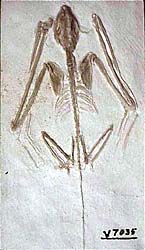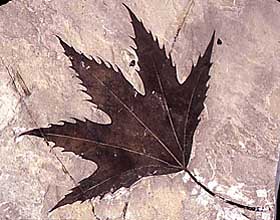jwu:
How so? Please be detailed.
...Additional proof gives a look at the deviation between the C14 age values from sediments, in comparison to those from wood. Then there is the extremely uneven age distribution of wood-sample inventories. "Secular variations of C14 were considered real," explains Korth, "while the bizarre consequences of calibration were ignored: Samples of wood from the middle-ages distribute uniformly along the time-axis, when calibration is omitted.
After calibration, the sample distribution shows so large variations that a coincidence must be excluded. Another example: C14 is produced by the radiation of our sun. The consequence of the apparent C14-variations were three distinct radiation levels for the sun, switching from one
into an other after a few decades. Do we need to believe this?"...
The emphasis added in my post was only Korth’s opinions, not Illig’s.
Korth does not say he agrees with Illig’s interpretation, but agrees that Illig
had noted the C14 discrepancy.
Instead, though, you make Illig’s crazy interpretation the strawman, when in
fact my point was there’s evidence of varying C14/C12 ratios in the recent
past.
The link that you read and to which you referred had the following topics of
discussion scheduled for the 19th International 14C Conference:
1. C14 concentrations of consecutive 40 single-yr tree rings at a peak area in the excess region between 2800 and 2625 cal BP using AMS.
2. Variations in atmospheric 14C during the Younger Dryas from Huon pine tree rings in Tasmania
3. Is it possible to find a good point estimate of calibrated radiocarbon date?
4. Wiggle-matching 14C-dating of historical materials and the systematic error consideration.
5. Exploring the potential causes of atmospheric Δ14C variation using multi-proxy evidence from Bahamian speleothems (34 to 45 ka)
6. Δ14C of Atmospheric CO2 over the Subtropical and Equatorial Pacific from Fall 2002 to Winter 2004
7. Atmospheric 14CO2 changes in the equatorial zone of western Pacific since 1994
8. Two decades of regular observations of 14CO2 and 13CO2 content in atmospheric carbon dioxide in central Europe: long-term changes of
regional anthropogenic CO2 emissions.
9. Radiocarbon ?Wiggles? in Great Lakes wood c. 10,000 to 12,000 BP.
10. Forty years of atmospheric radiocarbon variation studies in Slovakia.
11. North Atlantic surface ocean radiocarbon reservoir age variation: links to rapid global climate change
12. A radiocarbon shift in the eastern tropical Pacific during the early 19th century - oceanic response to atmospheric forcing?
13. Large 14C fluctuations in core PS2644 between 55 and 80 cal ka BP: Real or not?
14. Radiocarbon changes in the Northeast Atlantic Ocean over the past 50 years
15. What do carbon isotopes tell us about the age and source of CO2 lost by evasion from surface waters draining peatlands?
16. Monitoring of atmospheric excess 14C around Paks NPP
Here’s the link again for convenience:
http://www.rlaha.ox.ac.uk/c14/conference19/prog.html
So, in summary, and to answer your question at hand:
You did not refute my point. Instead, you set up Illig’s crazy interpretations
as a strawman.
My point was that the conference is addressing the invalidity of current
calibration procedures due to varying historical atmospheric C14/C12 ratios.
This is a prediction the Catastrophic Model makes (i.e.- affirmation), but
this is an important instance where
Uniformitarian predictions fail (i.e.- falsification).
jwu:
Where is this on the conference's schedule?
17. C14 concentrations of consecutive 40 single-yr tree rings at a peak area in the excess region between 2800 and 2625 cal BP using AMS.
18. Variations in atmospheric 14C during the Younger Dryas from Huon pine tree rings in Tasmania
19. Is it possible to find a good point estimate of calibrated radiocarbon date?
20. Wiggle-matching 14C-dating of historical materials and the systematic error consideration.
21. Exploring the potential causes of atmospheric Δ14C variation using multi-proxy evidence from Bahamian speleothems (34 to 45 ka)
22. Δ14C of Atmospheric CO2 over the Subtropical and Equatorial Pacific from Fall 2002 to Winter 2004
23. Atmospheric 14CO2 changes in the equatorial zone of western Pacific since 1994
24. Two decades of regular observations of 14CO2 and 13CO2 content in atmospheric carbon dioxide in central Europe: long-term changes of
regional anthropogenic CO2 emissions.
25. Radiocarbon ?Wiggles? in Great Lakes wood c. 10,000 to 12,000 BP.
26. Forty years of atmospheric radiocarbon variation studies in Slovakia.
27. North Atlantic surface ocean radiocarbon reservoir age variation: links to rapid global climate change
28. A radiocarbon shift in the eastern tropical Pacific during the early 19th century - oceanic response to atmospheric forcing?
29. Large 14C fluctuations in core PS2644 between 55 and 80 cal ka BP: Real or not?
30. Radiocarbon changes in the Northeast Atlantic Ocean over the past 50 years
31. What do carbon isotopes tell us about the age and source of CO2 lost by evasion from surface waters draining peatlands?
32. Monitoring of atmospheric excess 14C around Paks NPP
charlie:
Even if Illig's interpretation
of this data is crazy, the fact remains that C14/C12 ratios have varied
considerably, even in the very recent past.
jwu:
What do you consider "considerably"?
23 % just over the last 1300 years (300/1300=23%)
jwu:
Are you saying that at green river storm varves do look like annual varves at some places such as green river but they don't look like elsewhere that at all? Why would that be so? That does not make any sense...
That couldn't possibly be a straw man by the way. A straw man is argueing against a distorted and weaker version of the opponent's argument. I,e. "evolution says dogs give birth to cats", or "christianity says we have to eat human flesh"
jwu:
The left are storm/flood varves, the right are annual varves:
charlie:
How about a comparison between Green River and Lake Zurich. Your
comparing apple and oranges.
Here’s an uniformatarian comparison of The Green River Varves and Lake
Zurich (which is the appropriate comparision):
The famous Green River formation covers tens of thousands of square miles. In places, it contains about 20 million varves, each varve consisting of a thin layer of fine light sediment and an even thinner layer of finer dark sediment. According to the conventional geologic interpretation, the layers are sediments laid down in a complex of ancient freshwater lakes. The coarser light sediments were laid down during the summer, when streams poured run-off water into the lake. The fine dark sediments were laid down in the winter, when there was less run-off. (The process can be observed in modern freshwater lakes.) If this interpretation is correct, the varves of the Green River formation must have formed over a period of 20 million years.
Bob Schadewald
Board of Directors, National Center for Science Education
Figure 4 shows varves from the mesotrophic Lake Zurich where the light laminae represent chemical sedimentation prevailing during summers and the darker
laminae detrital sedimentation during winters.
http://home.entouch.net/dmd/age.htm
Note that each varve formation is created by the same hypothesized
alternating winter and summer layers.
Why I was pointing out your strawman arguement, is you compared Lake
Zurich’s alternating sequence to Lake Walensee Storm Varves.
This was in an attempt to refute my point that Green River’s supposed
annual layers are pentrated by fish and birds, transgressing multiple
“annual†varves.
You attempted to refute my point by setting up Lake Walensee storm
varves as a strawman, when in fact, Green River varves are accepted by
contemporary geologists as an “annual†varve sequence.
I don't think you intended to do this, but the
result still was a strawman response.
Furthermore, all it takes is a sufficiently anaerobic environment for corpses to remain as they are for years. A low content of oxygen in the deep parts of the river
basin and these fossils are not a mystery at all.
That's how we see things being preserved for years today as well.
Fish should not remain intact while very thin varves are slowly being
deposited around them. Even in anaerobic waters, one would not expect,
say a catfish with a 5†diameter (small to medium sized fish) to not decay
for 5 years.
If so, there would be many, many more catfish in the varves, especially
intepreting the varves as forming over millions of years. The fossil record in
these varves does not support this hypothesis.
Now, do we see annual varves accumulating today which also have
interbedded dead fish which might potentially become fossils under the right
conditions?
For varve theory to survive, a credible, observable, repeatable
model/mechanism for the preservation of dead fish until they
eventually get buried is required. Is this phenomena in process today and
where it can be observed?
In the Green River Formation ‘evaporites are succeeded by laminates
bearing fresh water fish fossils but barren of autochthonous benthic [natural
bottom] fossils’.
Boyer, B.W., Green River laminites: does the Playa-Lake Model really invalidate the Stratified-Lake Model? Geology 10(6):321-324, 1982, and references cited therein.
Furthermore, fish fossil density varies dramatically in vertical profile with
practically no change in lamina character.
In regards to the fossil fish of the Green River Formation, or any formation for that matter, fish taphonomy can aid in refining environmental interpretations. This is because modern analogues indicate that fossil preservation can be traced to several fairly recognizable conditions. Tetany is the extreme contraction of muscles during death, and indicates traumatic death. The muscular contractions of the death throes of fish result in widely gaping mouths and gills, fanned and stiffened fins, and, in extreme cases, arching of the body. Tetany indicates how a fish died. Together with the examination of the disarticulation of fish carcasses, tetany can tell much of post-death history by distinguishing pre-burial scavenging, post-burial bioturbation, disarticulation by water movement, and floating during decomposition. Tetany can occur from respiratory stress, heat shock, salinity or alkalinity shock. Heat shock, being associated with rising temperatures, necessarily results in disintegration of the carcass during floating. Fish dying of salinity shock will exhibit dehydration contortions and a lack of tetany. Therefore, only death from respiratory stress coupled with rapid burial will likely result in widely preserved tetany.
Ferber, C.T. and Wells, N.A., Paleolimnology and taphonomy of some fish deposits in 'Fossil' and 'Uinta' lakes of the Eocene Green River Formation, Utah and Wyoming, Palaeogeography, Palaeoclimatology, Palaeoecology 117(3-4):185-210, 1995.
Also, why were the fish remains not eaten by scavengers, and why are the
enclosing sediments not bioturbated?
Yet the split-fish layer contains well-preserved scavenging organisms such
as fish, turtles and crayfish.
And then there’s the problem of bird tracks. I can’t imagine what bird tracks
are doing in a deep water, anaerobic enviroment?
Bats :-?
The remarkable preservation of the leaves extends even to microscopic
structures within leaf cells that exhibit beautiful cellular detail. Just as
interesting, the original colour of the leaves has been preserved within the
laminated clays. The original green, brown, or red colours, suggestive of
autumn, are retained, which upon exposure promptly turn black.
Because of the above presented points, I question the idea of varve
formation being an uniform, annual process.
I believe it's reasonable to doubt varve counting is a valid absolute dating
method.










